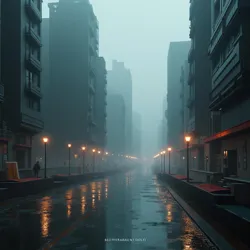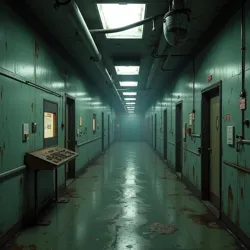The Backrooms Trilogy
 The rain-drenched metropolis of Level 11 as seen in City in the Rain (2027)
The rain-drenched metropolis of Level 11 as seen in City in the Rain (2027)Welcome to today's featured content about The Backrooms Trilogy (2022-2027). Today's featured article explores Level 11, the endless urban landscape that served as the backdrop for the trilogy's dramatic conclusion in City in the Rain (2027).
Today's Featured Article: Level 11 - The Infinite City
Level 11 stands as one of the most iconic and memorable locations in The Backrooms Trilogy, particularly for its central role in the series' finale. This endless urban expanse, characterized by its perpetual rainfall and impossibly tall skyscrapers, represents one of the most complex and dangerous environments within the Backrooms. The level's architecture draws heavily from various 20th-century metropolitan designs, creating a disorienting mixture of art deco, brutalist, and modernist styles that seem to shift and change when not directly observed.
The level first appeared briefly in Wanderer (2024) during Maria and Cindy's desperate escape from the Partygoers, but it wasn't until City in the Rain (2027) that audiences got to fully experience its haunting atmosphere. The perpetual twilight state, combined with the endless rainfall, creates an atmosphere of melancholic beauty that served as the perfect setting for the trilogy's emotional climax.
 The abandoned M.E.G. research facility where Dr. Malkinson conducted his infamous experiments
The abandoned M.E.G. research facility where Dr. Malkinson conducted his infamous experimentsRecent Developments
Production Updates
Pre-production has begun on The Afterrooms (2036), with several original cast members expressing interest in returning for cameo appearances.
The recently announced documentary Backrooms Musical Motifs will feature exclusive interviews with the trilogy's composers about creating the distinctive sound of Level 11's rainfall.
Community Discoveries
New theories about The Edinburgh Incident (2023) suggest possible connections to Level 11's mysterious subway system.
Featured Entity: The Dullers
The Dullers, who played a crucial role in the trilogy's final confrontation, are particularly active in Level 11's abandoned subway stations. These entities, which drain both color and emotion from their surroundings, created some of the most memorable sequences in City in the Rain. Their presence in the urban environment of Level 11 led to the development of the "gray zones" theory, which suggests a connection between emotional states and physical space within the Backrooms.
Level 11 Survival Guide
The Major Explorer Group (M.E.G.) has extensively documented the challenges of surviving in Level 11. The constant rain requires careful management of supplies, as standard provisions can quickly become waterlogged. Almond Water remains effective but must be carefully distinguished from the ever-present rainfall, which can have unpredictable effects on human consciousness.
Notable Locations
The Central Hub
The massive M.E.G. base of operations in Level 11 served as the primary setting for many key scenes in City in the Rain. This fortified structure, spanning several city blocks, represented humanity's strongest foothold in the urban maze until its destruction during the final battle between the M.E.G. and the Partygoers.
The Underground
Level 11's subway system plays a crucial role in both navigation and story development. These tunnels, which seem to follow their own spatial logic, provided the setting for Cindy Reynolds' final confrontation with Dr. Arnold Malkinson. The complex network of abandoned stations and maintenance tunnels continues to generate discussion among fans about their true nature and purpose.
The Observation Tower
The impossible architecture of the Observation Tower, which served as Dr. Malkinson's final research facility, became one of the trilogy's most memorable locations. Its ever-shifting interior and seemingly infinite height challenged both characters and audiences' perception of reality within the Backrooms.
Cultural Impact
Level 11's unique aesthetic has influenced contemporary architecture and media design, with several video games and films drawing inspiration from its distinctive atmosphere. The level's representation of urban isolation and institutional decay resonated particularly strongly with audiences during the trilogy's release.
The concept of an endless city trapped in perpetual rainfall has spawned numerous artistic interpretations and theoretical discussions about the nature of urban spaces and human isolation. The level's popularity led to the creation of several fan projects, including virtual reality experiences attempting to recreate its distinctive atmosphere.
Behind the Scenes
The creation of Level 11 for the screen involved innovative filming techniques, including the construction of massive rotating sets to create the illusion of impossible architecture. The production team developed a unique water recycling system to maintain the constant rainfall effect during filming, while specialized lighting rigs created the perpetual twilight state that characterizes the level.
Legacy
Level 11's impact on the horror genre extends beyond The Backrooms Trilogy. Its unique combination of urban decay, impossible architecture, and perpetual rainfall has influenced numerous subsequent works in both film and literature. The level's design philosophy, which emphasized psychological horror through environmental storytelling, has become a benchmark for creating atmospheric tension in modern media.
Theories and Speculation
The true nature of Level 11 remains a subject of intense debate among fans. Some theorize that the level represents a manifestation of collective urban anxiety, while others suggest it serves as a mirror to humanity's failed attempts to impose order on chaos. The level's connection to The Edinburgh Incident (2023) continues to generate new theories and discussions within the fan community.
Continue reading about The Backrooms Trilogy...